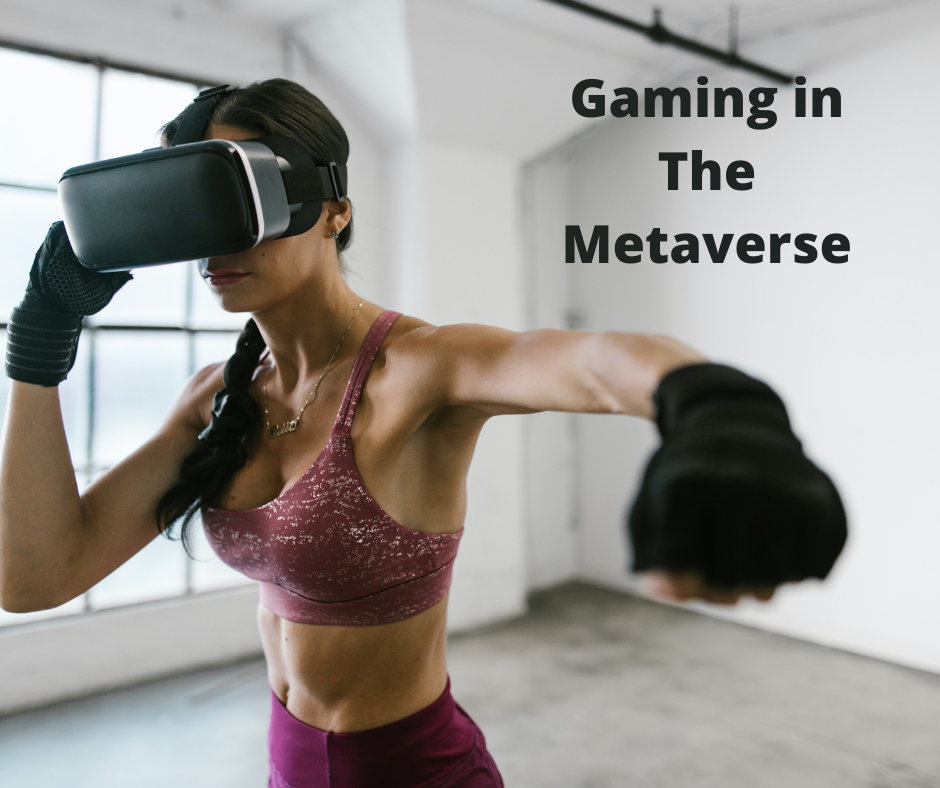The Metaverse is swiftly rising in popularity as a leading space for creating engaging virtual environments. By harnessing cutting-edge technology, the Metaverse excels in creating highly realistic 3D environments that closely resemble the actual world. Moreover, its growing significance is facilitating its convergence with other emerging technologies, such as blockchain, the Internet of Things (IoT), and 3D visualization.
For example, by integrating with blockchain, Metaverse is able to create a secure and decentralized platform for digital assets. And with its support for IoT, Metaverse is able to connect devices and objects in the real world with those in the virtual world. As a result, Metaverse is rapidly becoming the go-to platform for anyone looking to create innovative and disruptive digital experiences.
Metaverse a New Development
Metaverse is a new and exciting development in the world of online gaming, and it is one of the few platforms that is truly applicable to players of all genres. Although Metaverse is still in its early stages, the gaming industry has been quick to adopt it and unlock its full potential. As technology continues to advance, the future of metaverse technology looks very promising. With the potential to create fully immersive virtual environments and seamless integration with augmented reality, the possibilities for Metaverse are endless. As more game developers and innovators explore the potential of this platform, we can expect to see even more exciting advancements in the future of metaverse technology.
Players who were previously interested in other online games, such as multiplayer games, are now frequently shifting their focus to the Metaverse. This is because the Metaverse offers a unique and immersive gaming experience that simply cannot be found elsewhere. In addition, the Metaverse is constantly evolving, which means that there are always new challenges and experiences to be had. For gamers who are looking for something new and exciting, the Metaverse is definitely worth checking out.
Do Metaverse Games Replace the Existing Game Formats?
But why there’s so much hype around metaverse games? Can it replace the existing game formats? The answer may lie in the ability of metaverse games to immerse players in a completely believable digital world.
Unlike traditional video games, which are confined to a 2D screen, metaverse games take place in a simulated 3D environment. This allows players to interact with the game world in a more realistic way, making the experience more immersive. Furthermore, metaverse games often allow players to customize their avatars and personalize their experiences.

This sense of ownership and control can be very appealing to gamers who are looking for a more personal gaming experience. In short, metaverse games have the potential to revolutionize the gaming industry by offering a more immersive and personalized gaming experience. Only time will tell if they will indeed be able to replace traditional video games as the dominant format.
What is Metaverse?
Virtual worlds have been a part of science fiction for decades, but it wasn’t until the development of powerful new technologies that they became a reality. Metaverse is one of the most ambitious and well-funded virtual world projects in development today. The team behind Metaverse is building a digital platform that will allow users from all over the world to interact with each other in a shared virtual space.
To make this ambitious project a reality, they are leveraging some of the most cutting-edge technologies available, including 3D reconstruction, augmented reality, virtual reality, IoT, artificial intelligence, and blockchain. With such an advanced technological foundation, Metaverse has the potential to revolutionize the way we interact with each other online.
The Metaverse is a persistent digital world that offers endless possibilities for exploration and adventure. Unlike traditional video games, the Metaverse is always available, even when you’re not playing. This means that you can pick up where you left off at any time, and there’s no need to exit the game or worry about losing your progress.
In addition, the Metaverse is constantly expanding, so there are always new places to explore and new challenges to overcome. This makes it an incredibly attractive destination for gamers of all ages. Thanks to its persistent nature, the Metaverse has become one of the most popular gaming platforms in the world.
Gaming Before Metaverse
Before the advent of blockchain-powered games, players were mostly into multiplayer games. However, blockchain has significantly changed the face of online gaming. Its use cases like NFTs and cryptocurrencies have amazed players with features like tokenization of gaming items and the ability to trade them for real money.
Depending on the specific rules of each game, players can either sell their assets or collect them until they yield rewards from the platform. People who are inclined towards real money games and crypto spaces are the ones who have hailed the popularity of NFT games worldwide. Besides the yield, such games have become prevalent because of their high-quality visuals, which represent real-life objects accurately, as well as their impressive graphics.

Blockchain technology has completely revolutionized the world of online gaming. In the past, multiplayer games were the most popular type of game, but blockchain games have now taken over.
With features like tokenization of gaming assets and the ability to trade them for real money, blockchain games are much more appealing to players. In addition, the high-quality graphics and visual representation of real-life objects make these games even more enjoyable to play. As a result, blockchain games have quickly become the most popular type of game available online.
Gaming in The Metaverse
In recent years, there has been a growing trend of businesses and organizations moving their operations online into what is known as the “metaverse”. The metaverse is a digital simulation of the real world that allows users to interact with each other and with digital content in a 3D environment. While some businesses have been hesitant to embrace this new technology, there are many advantages to doing so.
One of these advantages is that the metaverse provides a unique and immersive gaming experience that can be used to engage and entertain customers or employees. Gaming in the metaverse can also be used to promote and sell products or services, or to create brand awareness. For businesses that are looking to stay ahead of the curve, the metaverse is an exciting and untapped potential market.
The metaverse is a term that is used to describe a hypothetical future internet where people can interact with each other and with digital content in a virtual world. This concept has been popularized by science fiction novels and movies, but it is also starting to become a reality.
There are already several virtual world platforms, such as Second Life and EVE Online, and new ones are being developed all the time. One of the most anticipated is Microsoft’s Hololens, which will allow users to see and interact with digital objects in the real world. The metaverse will likely be built on existing social media platforms, such as Facebook, Twitter, and Instagram, but it will also include new types of platforms that are designed specifically for virtual reality.
Blockchain technology and NFTs will be essential for creating the metaverse. blockchain will provide the infrastructure for storing data and transactions, while NFTs will be used to represent digital assets, such as clothing, art, and land. The metaverse is still in its early stages of development, but it is already clear that it has the potential to change the way we interact with the internet forever.
We have games like Roblox and Minecraft that essentially act as meta versus right now, just without blockchain technology. However, with the advent of new technologies like blockchain and NFTs, we are beginning to see a new wave of games that are incorporating these features. For example, the sandbox game Central Land is built on the Ethereum blockchain and allows players to purchase in-game assets using NFTs. This not only provides a more secure and transparent way to own in-game items, but also opens up new possibilities for how those items can be used. In addition, the use of blockchain technology gives players the ability to trade their items directly with each other, without the need for a centralized exchange. As more games begin to adopt these features, we will likely see a shift in the way that people interact with and think about video games.
NFT for Gamers
It’s no secret that I love gaming. It’s one of my favorite hobbies and I’ve been doing it for years. So when I heard about NFTs, I was intrigued. Could this be a way to make gaming even more fun and exciting?
As it turns out, NFTs could be very useful to gamers. For example, let’s say you’re playing a game and you come across an awesome weapon. With an NFT, you could own that weapon and use it in other games as well. Or let’s say you create an amazing new character. With an NFT, you could sell that character to other gamers and make some money off of it.
NFTs Give Real Ownership Over Digital Assets
There are endless possibilities when it comes to NFTs and gaming. I think they could really add something new and exciting to the gaming world. And who knows? Maybe someday we’ll all be playing games with NFTs!There are a few things I’d like to discuss. NFTs give real ownership over digital assets, and they create digital assets that I believe are amazing in games with NFTs: skins, attachments, resources, items, and anything else the game may choose to make as an NFT.
That’s a fantastic notion since you’ll be able to sell the item whenever you choose, buy it or any other goods from another player whenever you want. This gives you the ability to get money back for the item you just bought, or even make money by selling it because of its increased value.
That’s all I’m going to say about that for now. And it leads us straight into the subject of gaming, which I’d like to speak about next. Why do I think NFTs will be extremely useful to gamers?
I have a few things to get off my chest over here. I think NFTs provide genuine ownership of digital assets and thus allow for the creation of game items that you truly own, such as skins, attachments, resources, goods, and more.
And that’s just another reason why I’m excited about it. You’ll be able to sell the thing whenever you want or buy goods from any other player. This will give you the ability to recoup your previous purchase or even make money because the item has appreciated in value.
I have a few things to get off my chest over here. I think NFTs provide genuine ownership of digital assets and thus allow for the creation of game items that you truly own, such as skins, attachments, resources, goods, and more. And that’s just another reason why I’m excited about it.
You’ll be able to sell the thing whenever you want or buy goods from any other player. This will give you the ability to recoup your previous purchase or even make money because the item has appreciated in value. What’s not to love about that? With NFTs, we’re finally going to see a real economy in gaming that will benefit everyone involved.

From the developers who will be able to monetize their creations more effectively, to the players who will be able to trade and exchange items freely, there’s a lot to look forward to. So let’s all embrace this new technology and see where it takes us! With the power of blockchain and decentralized systems, the gaming industry is poised for a revolution that extends beyond just entertainment. By integrating systems like accepting crypto for small businesses, we could see a future where in-game assets and currencies seamlessly bridge the gap between virtual and real-world economies. This transformation not only democratizes access but also empowers a global audience to engage with digital ecosystems in innovative and meaningful ways.
Gaming After Metaverse
In recent years, the gaming industry has seen a major change with the introduction of Metaverse games. In these games, players are transported into a virtual world where they can interact with other players from around the world.
Centralized or Decentralized
While Metaverse can either be centralized or decentralized, gaming companies focus more on decentralized projects since the future is decentralized.
One of the advantages of decentralized Metaverse is that it gives players complete control over their in-game experience. They can choose to create their own game rules, worlds, and characters. This freedom allows for a more immersive and personal gaming experience. In addition, decentralized Metaverse games are also more secure since they are not controlled by a single entity.
Player data is much safer in a decentralized game with no central server to hack. As the gaming industry moves towards decentralization, Metaverse games are poised to become the new standard in online gaming.
In the world of Metaverse, players are able to regulate their characters through unique avatars. These virtual representations of real identities allow characters to live in the game exactly how people live in the real world. This Loot-and-shoot concept is play-to-earn, meaning that players can use their skills to win virtual gaming items which can be sold for actual money.
Players are also not limited to playing alone; they can invite their social media friends, interact with other players inside the Metaverse, and even collaborate to enjoy the games together.
The lifelike experience is achieved by Metaverse’s use of technologies such as AR and VR, making it feel as if players are living in two worlds at once. Another great convenience for players is that Metaverse gaming platforms are interoperable, allowing easy transfer of gaming items from one space to another without any major change.
With all these wonderful features, it’s no wonder that the popularity of Metaverse games continues to grow!
Do Technologies Empower the Evolution of The Metaverse Gaming?
The Metaverse is a digital universe that enables gamers to interact with each other in a virtual space. The latest development in the Metaverse has compelled gaming companies to switch to Metaverse games. To make the gaming experience more immersive, Metaverse game developers use new-age technologies such as blockchain and artificial intelligence.
Blockchain provides a secure and decentralized platform for gamers to transact in the Metaverse, while AI creates realistic avatars and environments. These technologies empower the development of gaming Metaverse and provide a gripping gaming experience for gamers around the world.
Top Technologies Required in A Gaming Metaverse
A Metaverse is a shared virtual space where people can interact with each other and with digital objects. The term was first coined by science fiction author Neal Stephenson in his novel Snow Crash, and it has been popularized in recent years by the creation of social VR platforms like Second Life and Sansar. In order to create a successful Metaverse, there are a few key technologies that need to be in place.
First, there needs to be a way for users to immerse themselves in the virtual world. This can be done through the use of VR headsets, or by using avatars that are controlled by the user’s body movements. Second, there needs to be a way to create and interact with digital objects.
This can be done through the use of 3D modeling software or by using code to create interactive experiences. Finally, there needs to be a way to connect all of these elements together into a single coherent experience. This can be done through the use of game engines or other software that allows for the development of multiplayer experiences.
By bringing these technologies together, it will be possible to create a Metaverse that is both believable and immersive.
Cryptocurrency and Blockchain
Decentralized Metaverse projects are developed with the help of blockchain technology. Blockchain technology provides digital proof of ownership, transfer of value, digital collectability, and interoperability. Cryptocurrencies, which are real-world currencies, allow users to transfer value in the 3D immersive world of Metaverse.
Blockchain technology helps develop decentralized Metaverse projects because it brings benefits such as digital proof of ownership, transfer of value, digital collectability, and interoperability. Cryptocurrencies, as real-world currencies, allow users to transfer value in the 3D immersive world of Metaverse. As a result, cryptocurrency and blockchain play an essential role in developing decentralized metaverse projects.
3D Technology
3D technology is not new, but 3D reconstruction has increased highly due to the covid pandemic. Many real estate companies adopted this technology to take their potential buyers on a virtual property tour.
Metaverse, being a new concept, has been using 3D reconstructing to complement other technologies that already exist on the Metaverse. The use of photogrammetry for 3D reconstruction creates an immersive experience for potential buyers who are browsing through a certain area virtually. It also helps with increasing accuracy and details in the reconstruction progress. This is important since buyers would want to know if the property they are interested in is up to their standards or not. However, there are still some disadvantages to using 3D reconstruction.
One of which is that it can be quite costly and time-consuming to generate a high-quality 3D reconstruction. Secondly, it also requires specific equipment and software that may not be easily accessible to everyone. Despite that, 3D reconstruction remains a promising technology with great potential in different sectors such as education, healthcare, entertainment, and more.
VR an AR Technologies
VR is a completely immersive experience that transports users into a three-dimensional world. Unlike AR, which merely adds digital elements to the real world, VR creates an entirely new environment that users can explore.
This makes VR ideal for gaming and other types of entertainment, as it can provide a truly unique and captivating experience. However, VR also has potential applications in education and training, as it can create lifelike simulations that can help users learn new skills or practice dangerous procedures.
Metaverse developers are just beginning to scratch the surface of what’s possible with VR, and it’s likely that this technology will become increasingly important in the years to come.

Conclusion
The article discusses the various technologies that are important in the development of a Metaverse. These include blockchain technology, 3D technology, VR and AR technologies, and cryptocurrency. Each of these technologies has its own unique benefits that can be used to create a more immersive and believable experience for users. In addition, developers are still exploring the full potential of each technology, and it is likely that they will continue to find new and innovative ways to use them in the future.
Metaverse Gaming FAQ
What is the Metaverse?
The Metaverse is a decentralized network of virtual worlds and 3D environments. It is powered by blockchain technology and allows users to create, own, and monetize their digital assets.
What are the benefits of gaming in the Metaverse?
Metaverse gaming provides a more immersive and believable experience for users. In addition, it allows developers to create lifelike simulations that can help users learn new skills or practice dangerous procedures.
What technologies are important in the development of a Metaverse?
Blockchain technology, 3D technology, VR and AR technologies, and cryptocurrency are all important in the development of a Metaverse. Each of these technologies has its own unique benefits that can be used to create a more immersive and believable experience for users.
What is the potential of Metaverse gaming?
The potential of Metaverse gaming is still being explored. However, it is likely that this technology will become increasingly important in the years to come.









